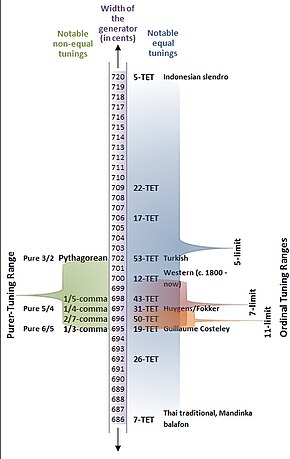17 equal temperament

In music, 17 equal temperament is the tempered scale derived by dividing the octave into 17 equal steps (equal frequency ratios). Each step represents a frequency ratio of 17√2, or 70.6 cents.
17-ET is the tuning of the regular diatonic tuning in which the tempered perfect fifth is equal to 705.88 cents, as shown in Figure 1 (look for the label "17-TET").
History and use
[edit]Alexander J. Ellis refers to a tuning of seventeen tones based on perfect fourths and fifths as the Arabic scale.[2] In the thirteenth century, Middle-Eastern musician Safi al-Din Urmawi developed a theoretical system of seventeen tones to describe Arabic and Persian music, although the tones were not equally spaced. This 17-tone system remained the primary theoretical system until the development of the quarter tone scale.[citation needed]
Notation
[edit]
Easley Blackwood Jr. created a notation system where sharps and flats raised/lowered 2 steps. This yields the chromatic scale:
- C, D♭, C♯, D, E♭, D♯, E, F, G♭, F♯, G, A♭, G♯, A, B♭, A♯, B, C
Quarter tone sharps and flats can also be used, yielding the following chromatic scale:
Interval size
[edit]Below are some intervals in 17-EDO compared to just.

| 17-et | |
| just | |
| 12-et |

| interval name | size (steps) | size (cents) | midi | just ratio | just (cents) | midi | error |
|---|---|---|---|---|---|---|---|
| octave | 17 | 1200 | 2:1 | 1200 | 0 | ||
| minor seventh | 14 | 988.23 | 16:9 | 996 | −7.77 | ||
| perfect fifth | 10 | 705.88 | 3:2 | 701.96 | +3.93 | ||
| septimal tritone | 8 | 564.71 | 7:5 | 582.51 | −17.81 | ||
| tridecimal narrow tritone | 8 | 564.71 | 18:13 | 563.38 | +1.32 | ||
| undecimal super-fourth | 8 | 564.71 | 11:8 | 551.32 | +13.39 | ||
| perfect fourth | 7 | 494.12 | 4:3 | 498.04 | −3.93 | ||
| septimal major third | 6 | 423.53 | 9:7 | 435.08 | −11.55 | ||
| undecimal major third | 6 | 423.53 | 14:11 | 417.51 | +6.02 | ||
| major third | 5 | 352.94 | 5:4 | 386.31 | −33.37 | ||
| tridecimal neutral third | 5 | 352.94 | 16:13 | 359.47 | −6.53 | ||
| undecimal neutral third | 5 | 352.94 | 11:9 | 347.41 | +5.53 | ||
| minor third | 4 | 282.35 | 6:5 | 315.64 | −33.29 | ||
| tridecimal minor third | 4 | 282.35 | 13:11 | 289.21 | −6.86 | ||
| septimal minor third | 4 | 282.35 | 7:6 | 266.87 | +15.48 | ||
| septimal whole tone | 3 | 211.76 | 8:7 | 231.17 | −19.41 | ||
| whole tone | 3 | 211.76 | 9:8 | 203.91 | +7.85 | ||
| neutral second, lesser undecimal | 2 | 141.18 | 12:11 | 150.64 | −9.46 | ||
| greater tridecimal 2⁄3-tone | 2 | 141.18 | 13:12 | 138.57 | +2.60 | ||
| lesser tridecimal 2⁄3-tone | 2 | 141.18 | 14:13 | 128.30 | +12.88 | ||
| septimal diatonic semitone | 2 | 141.18 | 15:14 | 119.44 | +21.73 | ||
| diatonic semitone | 2 | 141.18 | 16:15 | 111.73 | +29.45 | ||
| septimal chromatic semitone | 1 | 70.59 | 21:20 | 84.47 | −13.88 | ||
| chromatic semitone | 1 | 70.59 | 25:24 | 70.67 | −0.08 |
Relation to 34-ET
[edit]17-ET is where every other step in the 34-ET scale is included, and the others are not accessible. Conversely 34-ET is a subdivision of 17-ET.
References
[edit]- ^ Milne, Sethares & Plamondon 2007, pp. 15–32.
- ^ Ellis, Alexander J. (1863). "On the Temperament of Musical Instruments with Fixed Tones", Proceedings of the Royal Society of London, vol. 13. (1863–1864), pp. 404–422.
- ^ Blackwood, Easley (Summer 1991). "Modes and Chord Progressions in Equal Tunings". Perspectives of New Music. 29 (2): 166–200 (175). doi:10.2307/833437. JSTOR 833437.
- ^ Milne, Sethares & Plamondon 2007, p. 29.
Sources
- Milne, Andrew; Sethares, William; Plamondon, James (Winter 2007). "Isomorphic Controllers and Dynamic Tuning: Invariant Fingering over a Tuning Continuum". Computer Music Journal. 31 (4): 15–32. doi:10.1162/comj.2007.31.4.15. S2CID 27906745.
External links
[edit]- "The 17-tone Puzzle — And the Neo-medieval Key that Unlocks It" by George Secor
- Libro y Programa Tonalismo, heptadecatonic system applications (in Spanish)
- Georg Hajdu's 1992 ICMC paper on the 17-tone piano project
- "Crocus", 17 equal temperament, 9 tone mode on YouTube, by Wongi Hwang

